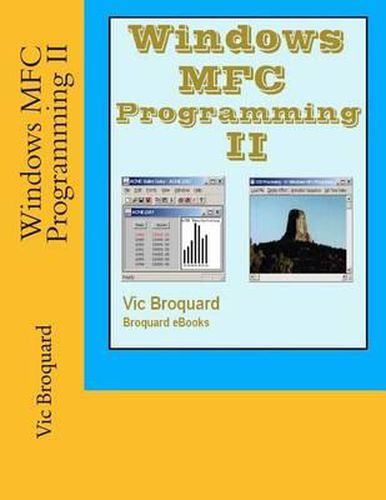Windows MFC Programming II
Vic Broquard

Windows MFC Programming II
Vic Broquard
Windows MFC Programming II is the first of two intermediate Windows MFC Microsoft Foundation Class programming textbook, replacing my now out-of-print Intermediate MFC. The book assumes that the reader is skilled in basic Windows MFC programming and proceeds to cover many more advanced topics, especially printing and complex document view handling. Database access is presented as well as many other more advanced topics and controls, such as the list and tree views. Designed for a college level course or for the experienced self-taught, Windows MFC Programming II covers many advanced Windows MFC (Microsoft Foundation Classes) C++ Programming topics. It is designed to provide you with the skills needed for an entry level career in Windows MFC programming. Just check out the table of contents to see what I mean. Windows MFC Programming II assumes that the reader already knows basic MFC programming, covered in the previous book, Windows MFC Programming I. When you have finished this book, you will want to obtain Windows MFC Programming III, which finishes the in depth coverage of intermediate MFC topics. Fonts are covered in great depth, focus is on the many ways that fonts can be created and used in various functions. There are six major and quite different printing situations. Very little information is found in other texts on just how to print in various situations. This book rectifies that deficiency. Details of scaling and the use of various mapping modes are illustrated, including the construction of a ruler. Both list and tree controls are presented in a variety of ways and uses. The document view architecture is reviewed and then greatly expanded upon in a variety of programming situations. Details of just how the document and views are dynamically created by the framework are covered as well. Methods of handling WYSIWYG are presented, along with how to handle word wrap and justification of text. Image processing is detailed including how to handle printing an image in many different ways. Coupling your application to databases is presented both using the ODBC classes as well as the older DAO classes. Printing database based reports is covered as well.
This item is not currently in-stock. It can be ordered online and is expected to ship in approx 2 weeks
Our stock data is updated periodically, and availability may change throughout the day for in-demand items. Please call the relevant shop for the most current stock information. Prices are subject to change without notice.
Sign in or become a Readings Member to add this title to a wishlist.


